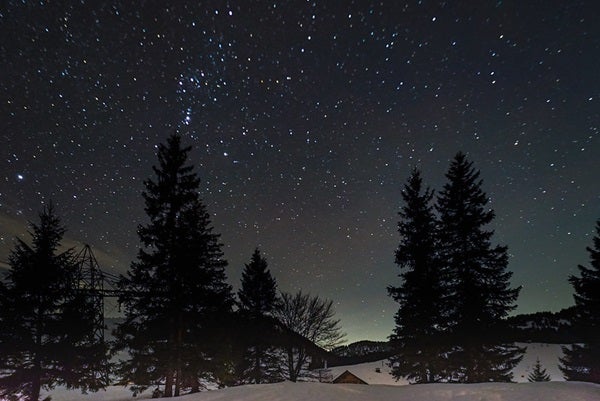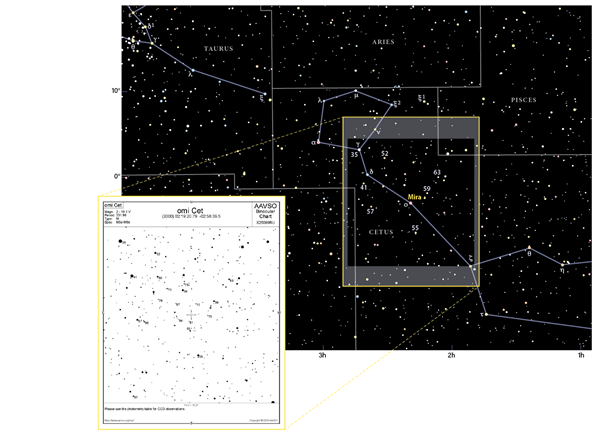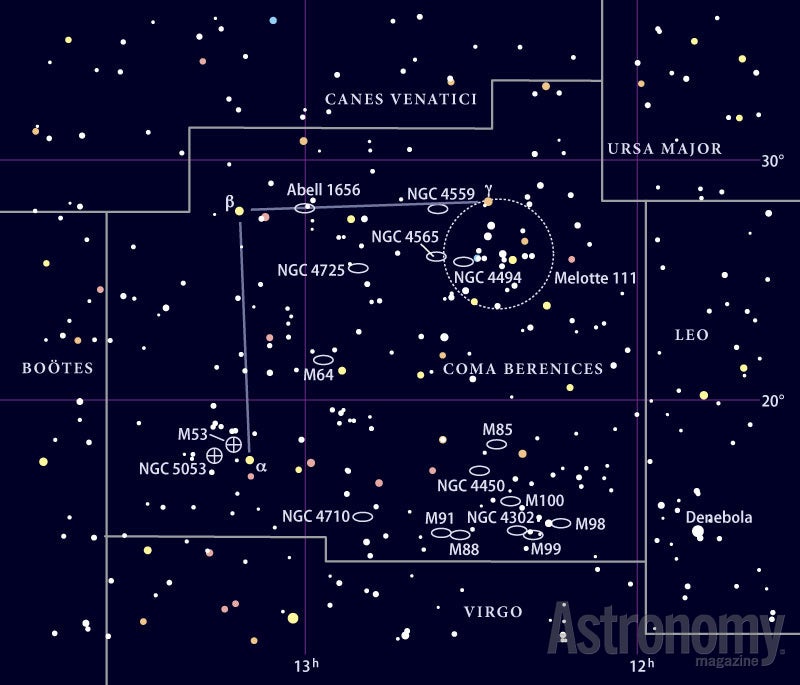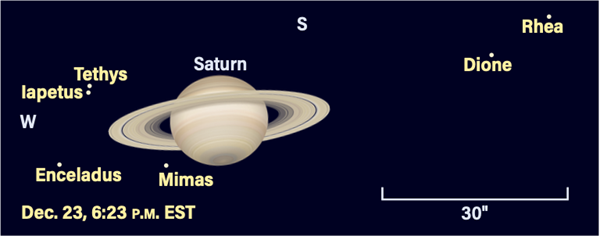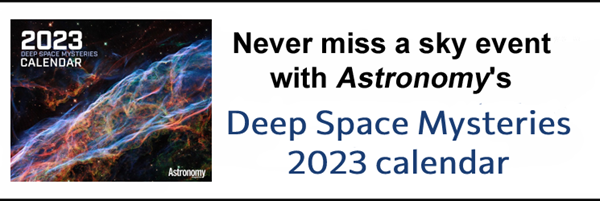Friday, December 16
Last Quarter Moon occurs at 3:56 A.M. EST. This phase dominates the morning sky and shows off features in lighting conditions that are the reverse of earlier phases as the Sun sets over the lunar landscape.
A few hours after sunset, Cancer the Crab follows Orion and Gemini up into the sky from the eastern horizon. Floating in the middle of this constellation is the Beehive Cluster (M44), a famous naked-eye open cluster also known as Praesepe the Manger. Because it’s visible without a telescope, this group of young stars has been known since antiquity. To many observers, it appears as a fuzzy, cloudlike patch of light in the sky. Look for it below the two bright heads of Gemini, Castor and Pollux, or to the lower left of Procyon in Canis Minor. With modern binoculars or a telescope, you can bring its luminaries into sharp focus, calling up some 100 stars.
The ecliptic — the plane of the solar system — passes close by this cluster, meaning the Moon and planets often cozy up to these celestial pollinators on the sky.
Sunrise: 7:16 A.M.
Sunset: 4:36 P.M.
Moonrise: —
Moonset: 12:33 P.M.
Moon Phase: Waning crescent (46%)
*Times for sunrise, sunset, moonrise, and moonset are given in local time from 40° N 90° W. The Moon’s illumination is given at 12 P.M. local time from the same location.
Saturday, December 17
An hour or two after sunset, look south and you’ll spot bright Jupiter (magnitude –2.5) hanging some 50° above the horizon in Pisces. About 19.5° southwest (to the lower left) of the planet is 2nd-magnitude Diphda, the beta star of the large constellation Cetus the Whale.
From there, slowly swing your gaze 28° northeast (to the upper left) to land on Mira, the “wonderful” star that sits roughly in the center of the constellation.
But there’s a catch — Mira isn’t there! Mira is a well-known variable star whose brightness ranges from 2nd magnitude (easily visible to the naked eye) to 10th magnitude (completely invisible without binoculars or a telescope). The star’s period is about 332 days and it spends half that time — nearly half of each year — too faint for unaided viewing. Its last maximum was July 17, so it’s been fading ever since and is now below the naked-eye threshold of roughly magnitude 6.
But all is not lost — if you have binoculars or any size telescope, they will easily bring Mira back into view. Use the larger, colored chart above to find the general area where Mira should be, then switch to the smaller, black-and-white chart to pin down its precise location and determine its magnitude relative to the surrounding stars. The numbers on the smaller chart correspond to each star’s magnitude with the decimal point omitted (so, a star labeled 63 has a magnitude of 6.3). You can also download a PDF of the charts below.
Sunrise: 7:16 A.M.
Sunset: 4:36 P.M.
Moonrise: 12:41 A.M.
Moonset: 12:54 P.M.
Moon Phase: Waning crescent (36%)
Sunday, December 18
Can you find the North Star? Second-magnitude Polaris currently marks Earth’s North Celestial Pole, guiding wayward travelers and serving as the point around which all the stars in the Northern Hemisphere appear to rotate. Polaris is also the last star in the handle of the Little Dipper asterism, which is drawn from the elongated tail of Ursa Minor the Little Bear. If you’re having trouble finding it, first locate the Big Dipper instead. The two stars on the outer edge of its bowl (the opposite side from where the handle connects) are called the Pointer Stars — draw a straight line up through these stars from bottom to top and continue it through the sky. The next star you see along this line will be Polaris, some 29° from Dubhe, which marks the top right-hand corner of the Bid Dipper’s bowl when facing upright.
Once you’ve located north and the North Star, let’s take advantage of the moonless evening hours to skip to a dim target very nearby: the spiral galaxy NGC 3172, sometimes called Polarissima Borealis. This is a challenging target perfect for dark skies — at magnitude 13.6, you’ll want a large (10 inches or more) scope to spot it. NGC 3172 sits just 1.5° from Polaris in the direction of Camelopardalis on the sky. This faint galaxy doesn’t show much detail even in a large scope, appearing as a roughly oval-shaped haze about 0.5′ across. Its center may appear brighter than the outskirts. Although it’s not visually interesting, it’s still an intriguing target simply because it lies so close to the celestial pole!
And right now, there’s a bonus in this region: Comet C/2020 V2 (ZTF), now 10th magnitude, is quickly approaching the pole as well. Tonight, it lies 5° south-southeast of Polaris and may be visible with mid-sized telescopes. See if you can spot its soft glow and keep an eye on this part of the sky; ZTF will slide due south of our pole star in just a few days.
Sunrise: 7:17 A.M.
Sunset: 4:36 P.M.
Moonrise: 1:46 A.M.
Moonset: 1:18 P.M.
Moon Phase: Waning crescent (27%)
Monday, December 19
Stellar occultations occur when a body in our solar system passes between Earth and a distant star from our point of view. This happens because the planets, moons, and asteroids of our solar system are nearer than the stars and can appear to “overlap” on the two-dimensional view of the sky we see. Recently, the Moon passed in front of Mars in just such an event. Early this morning, there’s another occultation of a much rarer type.
Astronomers estimate that starting at approximately 11h49m22s UT on December 19 (3:49:22 A.M. PST), Comet 29P/Schwassmann–Wachmann 1 will briefly occult a 12th-magnitude field star in the constellation Gemini. The coordinates of this star are Right Ascension 06h 43m 51.1s and Declination +29° 28′ 12.1″. The comet is currently 16th to 17th magnitude, so a large telescope will be necessary to see it — though a smaller telescope will still see the star winking out and then back into view, so don’t give up if you have a modest instrument.
The occultation itself is only visible from a small portion of Earth, as the celestial alignment is only perfect from limited points on the globe. But those lucky U.S. observers in southern California may catch the event, as the track is predicted to cross Palomar, Los Angeles, and Long Beach on its way to the U.S.-Mexico border. If you’re an experienced astroimager, consider recording video to send to the Collaborative Occultation Resources and Archive (CORA). You can find more information about submitting observations, as well as additional details and maps for this exciting event, on CORA’s page for the occultation as well as the British Astronomical Association’s page for the event.
Observing occultations provides valuable insight into the intervening object. Researchers hope to learn more about the size and shape of 29P, as well as details about its coma and any possible debris rings surrounding the comet.
Sunrise: 7:17 A.M.
Sunset: 4:37 P.M.
Moonrise: 2:53 A.M.
Moonset: 1:44 P.M.
Moon Phase: Waning crescent (18%)
Tuesday, December 20
This is a great week to enjoy naked-eye open clusters, so let’s now turn to Coma Berenices, best visible in the early morning hours leading up to dawn. This constellation rises ever higher in the hours after midnight, nestled between Canes Venatici and Virgo in the east.
We’re planning to home in on Melotte 111, a magnitude 1.6 cluster spanning about 300′ (that’s 5° of sky!). It’s located due south of magnitude 4.3 Gamma (γ) Comae Berenices; Gamma itself sits at the northern edge of the cluster but is not part of the grouping. Melotte 111, also called the Coma Berenices star cluster, is another object that has been known since antiquity. The brightest luminaries are roughly magnitude 5, visible to the naked eye, while the cluster also contains some 50 stars brighter than 10th magnitude that are easily visible through binoculars or a finder scope. Rather than moving toward or away from our Sun, this young group of stars appears to be moving alongside out solar system through the Milky Way.
As you can see from the chart above, this simple constellation is awash in clusters and galaxies that really show off in this morning’s dark sky. Even after the Moon rises, its feeble light shouldn’t interfere much. Use the chart or check out our recent print feature on deep-sky gems in Coma Berenices to find more targets for your telescope or binoculars.
Sunrise: 7:18 A.M.
Sunset: 4:37 P.M.
Moonrise: 4:06 A.M.
Moonset: 2:15 P.M.
Moon Phase: Waning crescent (10%)
Wednesday, December 21
Mercury reaches greatest elongation east of the Sun (20°) at 10 A.M. EST this morning. The solar system’s smallest planet is visible in the evening twilight, shining at magnitude –0.5. Mercury now stands some 8° above the southwestern horizon half an hour after sunset. Its light will linger in the twilight before the planet disappears from the sky around 6 P.M. local time.
Nearby, blazingly bright Venus (magnitude –3.9) is some 4.5° high at the same time, 5° to Mercury’s west (lower right). Although Venus is closer to the horizon, it’s so bright that it will remain easy to spot until it sets about an hour after the Sun. In just a few days, a delicate crescent Moon will join this pair in the Christmas Eve sky. Stay tuned for next week’s column, which will have more details on that lovely event.
The winter solstice occurs at 4:48 P.M. EST today, ushering in the official start of the winter season in the Northern Hemisphere. (This same date marks the beginning of summer in the Southern Hemisphere.)
Finally, Mars passes 8° north of the bright red giant Aldebaran in Taurus at 11 P.M. EST tonight. Regardless of whether you’re a night owl or an early riser, we’ll check out this pair as our target for tomorrow.
Sunrise: 7:19 A.M.
Sunset: 4:38 P.M.
Moonrise: 5:22 A.M.
Moonset: 2:55 P.M.
Moon Phase: Waning crescent (4%)
Thursday, December 22
Just a few weeks after opposition, Mars remains in the sky most of the hours it is dark, setting a few hours before sunrise and rising shortly before the Sun sets. If you’re up in the few hours after midnight, look west to see Taurus the Bull sinking toward the horizon. The brightest point of light currently in this constellation is not a star, but is instead the Red Planet, Mars. Study that light for a few moments and you may notice it appears orangey-red. Compare that to the star 8° to its south (lower left) — this luminary is magnitude 0.9 Aldebaran, whose light may also appear orange or red. Aldebaran is a massive, aging red giant star that puts out more light — but is a cooler temperature — than the Sun.
To the pair’s lower right in the early morning is the unmissable Pleaides star cluster, which sparkles as it sinks toward the horizon.
If you prefer evening viewing, the setup is much the same — this time, look east as soon as the Sun sets to spot Taurus already well above the horizon. Now, Mars sits to Aldebaran’s upper left, with the Pleiades to the pair’s upper right. Below them, another red giant is rising: Betelgeuse, the bright star marking the shoulder of Orion the Hunter, whose curving bow of stars points toward the body of the Bull.
Sunrise: 7:19 A.M.
Sunset: 4:38 P.M.
Moonrise: 6:39 A.M.
Moonset: 3:46 P.M.
Moon Phase: Waning crescent (1%)
Friday, December 23
New Moon occurs at 5:17 A.M. EST this morning, ensuring the skies stay dark for days of deep-sky observing next week.
Tonight, catch magnitude 0.8 Saturn in the southwest shortly after sunset. It sits just 2.5° west of Deneb Algedi. Through a telescope, the ringed planet stretches 16″, while its rings span slightly more than twice that length, some 36″. They’re now tilted 14° to our line of sight; this angle will shrink over the coming months, rendering the rings closer to edge-on.
Take some time to enjoy those rings as well as the planet’s brightest moon, magnitude 8.5 Titan, 2.5′ to the planet’s west tonight. But closer in, look also for the 10th-magnitude moon Tethys, which lies just 20″ southwest of the center of Saturn’s disk. Nearby is 11th-magnitude Iapetus, which will pass close to Tethys starting around 6:23 P.M. EST. Through your telescope, the two small, dim points of light will appear to merge, then slowly part ways again. By 7:30 P.M. EST, they have split and stand 3″ apart, easy to separate through a scope once more.
Sunrise: 7:20 A.M.
Sunset: 4:39 P.M.
Moonrise: 7:53 A.M.
Moonset: 4:49 P.M.
Moon Phase: New

